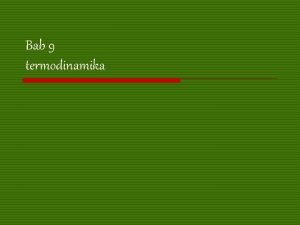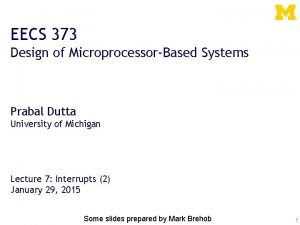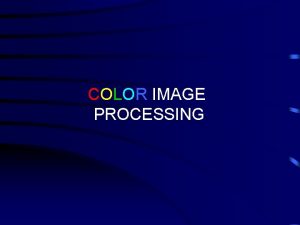240 373 Image Processing Montri Karnjanadecha montricoe psu






















- Slides: 22

240 -373 Image Processing Montri Karnjanadecha montri@coe. psu. ac. th http: //fivedots. coe. psu. ac. th/~montri 240 -373: Chapter 1: Introduction 1

Chapter 1 Introduction 240 -373: Chapter 1: Introduction 2

Definition of Image Processing • Processing of an image, typically by a computer, to produce another image • The computer processing of pictures ( the manipulation of images by computer) 240 -373: Chapter 1: Introduction 3

Applications of Image Processing • • • Pictorial databases Graphic design Medical imaging Object recognition Picture enhancement Microscopy 240 -373: Chapter 1: Introduction 4

Digital Image Processing System Console Image digitizer Input image storage Computer Output image storage Image recorder Program library 240 -373: Chapter 1: Introduction 5

Image Shape • An image is usually defined as rectangular grids of pixels • Image(1. . M, 1. . N), Image (10, 5( 240 -373: Chapter 1: Introduction 6

Color Standards • A pixel color is represented as a point in 3 -D space. Axis may be labeled as independent colors such as R, G, B or may use other independent indicators such as Hue, lightness, saturation. • RBG, HSV, HSL are the most popular. 240 -373: Chapter 1: Introduction 7

RGB • RGB (Red green blue) – For CRT display (TV, computer monitor) – Additive combination of r g and b 240 -373: Chapter 1: Introduction 8

HSV • HSV (Hue Saturation Value) Hue is effectively a measure of the wavelength of the main color. It has a value between 0 -255 (0 -360 o, Red = 0 o, Green=120 o and Blue=240 o. ) Hue can be calculated from RGB values as follows: Rh = R - min (R, G, B) Gh = G - min (R, G, B) Bh = B - min (R, G, B) At least on of these values is 0. Hue value is in between. 240 -373: Chapter 1: Introduction 9

HSV For example if Rh = 0 Hue angle = (240 x. Bh + 120 x. Gh ) / (Bh + Gh) If two are zero, then hue is the angle corresponding to the third non-zero color. If three are zero, then there is no color hue. The monitor will display a gray level (between black and white). 240 -373: Chapter 1: Introduction 10

Saturation • Saturation is the amount of pure hue in the final color If Saturation = 0, final color is without hue ( white light only) If Saturation = 255, no white light in final color Saturation = (max(R, G, B) - min (R, G, B)) / max(R, G, B) 240 -373: Chapter 1: Introduction 11

Value • Value (brightness) is a measure of the intensity of the brightest component and given by Value = max(R, G, B) 240 -373: Chapter 1: Introduction 12

The HSV Model 240 -373: Chapter 1: Introduction 13

HSV Example Given R=100, G=200, B= 40, convert this RGB color model to HSV. Rh = 100 - min(100, 200, 40) = 60 Gh = 200 - min (100, 200, 40) = 160 Bh = 40 - min (100, 200, 40) = 0 H = (60*0 + 160*(120*256/360))/(60+160( 240 -373: Chapter 1: Introduction 14

HSV Example (Continued( Saturation = (max(R, G, B) - min (R, G, B)) / max(R, G, B) = (max(100, 200, 40)-min(100, 200, 40/(( max(100, 200, 40( 200 -40)/200) = %80 = 0. 8 = Saturation = 80*256/100 = 204 Value = max(100, 200, 40)200 = %78 = 100/256*200 = 240 -373: Chapter 1: Introduction 15

240 -373: Chapter 1: Introduction 16

HLS (Hue Lightness Saturation) • Similar to HSV except that the hue angle start at Blue = 0 o, and the model is double cone with a lightness axis going from L=0 (black) to L=1 (white) • For HLS, hue is calculated the same way as for HSV model except Blue = 0 and lightness and saturation are given by: • Lightness = (max(R, G, B) - min(R, G, B))/2 (max+min)/(max-min) if L <= 0. 5 (max-min)/(2 -max-min) otherwise • Saturation = 240 -373: Chapter 1: Introduction 17

HLS 240 -373: Chapter 1: Introduction 18



The Human Vision • Better than any camera yet developed • Eye has 2 classes of discrete light receptors; Cones and rods • 6 -7 million cones, sensitive to bright light • >= 75 Million rods, sensitive to light intensity but not color • eye color perceptions 240 -373: Chapter 1: Introduction 21

Color Additive • Problem with CRT 240 -373: Chapter 1: Introduction 22
 High boost filtering matlab
High boost filtering matlab Point processing in digital image processing
Point processing in digital image processing Histogram processing in digital image processing
Histogram processing in digital image processing Neighborhood processing in digital image processing
Neighborhood processing in digital image processing What is point processing in digital image processing
What is point processing in digital image processing Morphological
Morphological Translate
Translate Linear position invariant degradation
Linear position invariant degradation Image compression model in digital image processing
Image compression model in digital image processing Image segmentation in digital image processing
Image segmentation in digital image processing Error free compression
Error free compression Image sharpening and restoration
Image sharpening and restoration Image geometry in digital image processing
Image geometry in digital image processing Isopreference curve
Isopreference curve Image transform in digital image processing
Image transform in digital image processing Image geometry in digital image processing
Image geometry in digital image processing Noise
Noise Umich eecs 373
Umich eecs 373 Eecs 511
Eecs 511 Eecs 373
Eecs 373 Contoh soal kapasitas kalor pada tekanan tetap
Contoh soal kapasitas kalor pada tekanan tetap Dte vs dce pinout
Dte vs dce pinout Eecs 373
Eecs 373










































